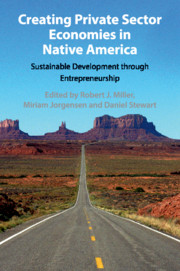 Creating Private Sector Economies in Native America
Creating Private Sector Economies in Native America Book contents
- Creating Private Sector Economies in Native America
- Creating Private Sector Economies in Native America
- Copyright page
- Contents
- Figures
- Tables
- Contributors
- Introduction
- Part I The Setting
- 1 Private Sector Economic Development in Indian Country
- 2 Opportunities to Diversify: Reservation Workplaces and Job Numbers Compared to Nearby County Areas
- Part II Policy Barriers and Policy Needs
- Part III Learning from Business Scholars
- Part IV From Learning to Doing: Examples of Entrepreneurship in Indian Country
- Index
- References
2 - Opportunities to Diversify: Reservation Workplaces and Job Numbers Compared to Nearby County Areas
from Part I - The Setting
Published online by Cambridge University Press: 15 October 2019
- Creating Private Sector Economies in Native America
- Creating Private Sector Economies in Native America
- Copyright page
- Contents
- Figures
- Tables
- Contributors
- Introduction
- Part I The Setting
- 1 Private Sector Economic Development in Indian Country
- 2 Opportunities to Diversify: Reservation Workplaces and Job Numbers Compared to Nearby County Areas
- Part II Policy Barriers and Policy Needs
- Part III Learning from Business Scholars
- Part IV From Learning to Doing: Examples of Entrepreneurship in Indian Country
- Index
- References
Summary
This chapter presents and discusses some of the most comprehensive data on workplaces (establishments) and jobs on federally recognized American Indian reservations. Although the distribution of workplaces across industries is similar for reservations and nearby county areas, the number of reservation workplaces per resident is about 30 percent lower. Nonetheless, the overall number of jobs located within reservations is roughly on par with or even somewhat higher than in the county comparison areas, largely due to high job counts in the gaming industry and government sector. Outcomes can vary significantly from one reservation to another within the overall group of reservations. Nonetheless, the overall pattern suggests an opportunity to expand tribal economies by diversifying their private sectors beyond the gaming and government workplaces that dominate reservation job numbers today.
Keywords
- Type
- Chapter
- Information
- Creating Private Sector Economies in Native AmericaSustainable Development through Entrepreneurship, pp. 37 - 64Publisher: Cambridge University PressPrint publication year: 2019
